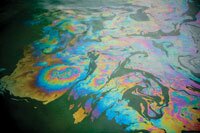ESSAY- Worse than Jaws: Why it's not safe to go in the water

Dr. Mark Rennaker has surfed San Francisco's Ocean Beach for three decades and suffered from repeated sinus, lung, eye and ear infections. As a general practitioner, he has offered frequent beachside consults to fellow surfers and anglers with similar maladies. "It's a chronic condition of coastal life," he says, caused by exposure to polluted water.
Health advisories and beach closings for U.S. oceans, bays and the Great Lakes in 2008 topped 20,000 events for the fourth year running, says the Natural Resource Defense Council (NRDC) in their just-published annual report on water quality at vacation beaches.
And the situation isn't improving, says the NRDC.
Infections resulting from a day at the beach have increased steadily over recent decades– and are seriously underreported because people rarely associate an illness with a lake paddle or day in the surf, especially if they get sick days or weeks later, according to a Centers for Disease Control and Prevention report.
Data show that up to 10 percent of people who jump into the Great Lakes end up in bed or the emergency room. Swimming in bacteria, parasite- or virus-laden water can transmit anything from pink eye, dysentery, and respiratory infections to hepatitis or meningitis.
Last year logged the fourth-highest beach closings/advisories over the 19 years NRDC has tracked water quality. Stormwater was the culprit in two-thirds of incidents that could be linked to a pollution source, highlighting the fact that human and animal wastes are not being properly managed in the United States.
Across the U.S., summer thunderstorms often flush huge amounts of feces, bacteria and a witch's brew of pollutants from rooftops, streets, croplands, yards, and industrial farms into lake, river, and ocean waters. The next day, swimming is off-limits– or should be. That's because in many cities and suburbs, storm drains and sewage systems run through a "combined sewer" that leads to a sewage treatment plant. In big storms, runoff and untreated sewage combine in storm drains, overwhelming sewage plants which are bypassed.
In cities with aging sewage treatment systems– places like New York, Boston, Los Angeles, Seattle, and Chicago– nearly every rainfall overwhelms the system.
"After a hard rain," writes former NY/NJ Baykeeper Andy Willner, "the human excrement of roughly 40 million Americans in 772 communities in 31 states flows untreated straight out the pipe into America's rivers, lakes, and bays."
But there's another troubling wrinkle here. Some 13,000 beach closings were attributed to "unknown sources of pollution." That's because stormwater contains more than just sewage. It's become a soup of trash, oil, asbestos, copper, lead, cadmium and other heavy metals from industrial sites, buildings, and paving materials, as well as pesticides from industrial farms and backyards. What exposure to these substances does to swimmers is difficult to gauge and largely unstudied.
The federal Beach Act passed in 2000 increased water monitoring and made test results more publicly accessible, but it fell short of requiring investigation into pollution sources. Dr. Rennaker notes that current water testing is fixated on "fear of feces" and should be expanded to test for disease-causing microbes, for red tide outbreaks that sicken people and kill sea life, and for toxic chemicals. Twenty-year-old public health standards fail to address many water-borne illnesses.
State laws determines how much– if any– testing is done, whether beaches are closed, and whether or not the public is notified when polluted water threatens health, a policy that must change.
Clearly water quality is at a crisis point: A 2002 Environmental Protection Agency (EPA) report found that 45 percent of our waterways are too polluted for swimming or fishing. However, the Clean Water Act was weakened during the Bush administration, allowing development of nature's own water purifiers, our wetlands.
The Obama administration needs to restore the Clean Water Act's wetland protections. And factory farms should not be exempt from federal protections; many industrial livestock operations produce as much sewage as small cities. Urban sewage systems must be upgraded. Congress should also ratify the Clean Coastal Environment and Public Health Act, which provides funds to track down polluters. And the EPA needs to step up enforcement.
Certainly public support is there. From 1998 to 2004, Americans voted to pay $14.2 billion for improved water protection. We already have the technology to reduce polluted runoff by implementing Low Impact Development practices like green roofs, rain gardens, and permeable pavements that keep runoff from overwhelming sewers.
America's polluted waters are a nationwide problem needing a comprehensive solution involving all levels of government. There's no reason why Americans should be sickened by a day at the beach.
~
Sharon Guynup's writing has been published by the New York Times Syndicate, Popular Science, The Boston Globe, nationalgeographic.com, and this essay was syndicated by Purcellville-based Blue Ridge Press.
#